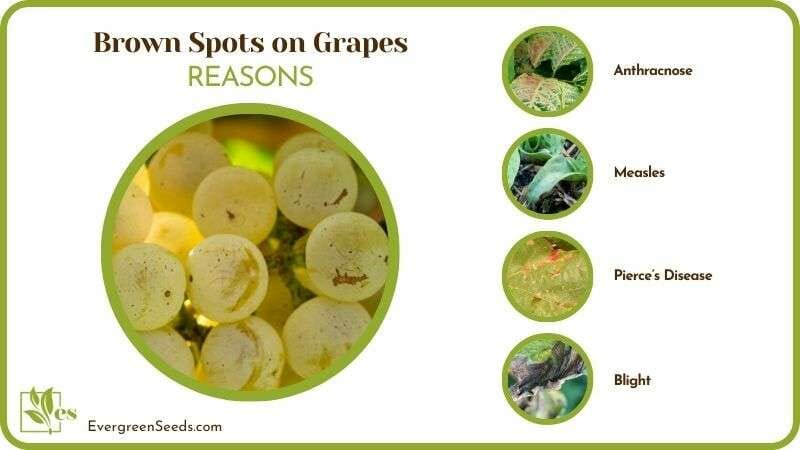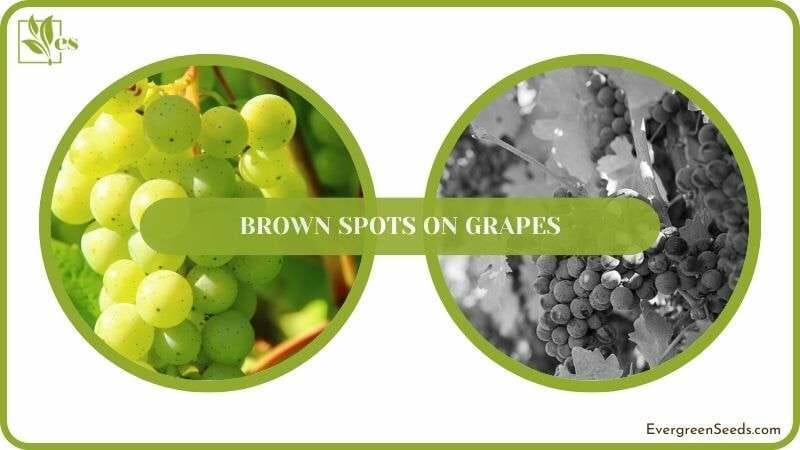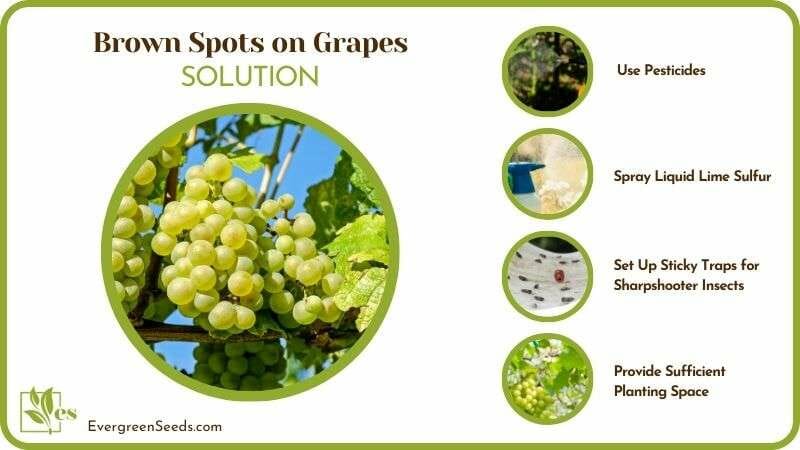- How to Save an Overwatered Snake Plant: Expert Tips and Solutions - October 17, 2024
- Overwatered Sunpatiens: Signs, Solutions, and Prevention Tips - October 17, 2024
- What Do Overwatered Orchids Look Like? Identifying Signs and Solutions - October 17, 2024
Brown spots on grapes are issues that mainly happen because of pest infestations, certain fungal infections, bacterial diseases, and poor growing conditions.
Fortunately, there are tried-and-tested solutions to all of these, which we will be discussing in this article. Continue reading to learn more about them and their right fixes.
JUMP TO TOPIC
Why Are There are Brown Spots on Grapes?
There are brown spots on grapes because of anthracnose, or due to measles, pierce’s disease and blight. In addition, it could also be due to grape black rot, or having pest infestation, and maybe due to poor growing conditions it is subjected to.
– Anthracnose
A fungal disease, also known as grapevine black spot, results in the development of brown or black patches on the fruit. The disease generally manifests itself during the warm, wet seasons. It has unique patches that look like a bird’s eye, hence the variant term “bird’s eye rot.” It causes all of the plant’s green parts, including the fruit, stems, vines, and leaves, to be affected.
Fruits that are most impacted lose their nutrition and begin to turn green or purple. The summer heat considerably increases the fruit’s susceptibility to this fungus and the absence of fungicide application. It creates a simple pathway for the Ampelina to contaminate and significantly defoliate the grapes.
– Measles
Another type of fungal infection, measles, attacks grapevines through damaged and rotting plant areas. It causes different symptoms, ranging from discoloration of the leaves that seem to dry out, to sunburn and sometimes a reddish-yellow appearance. Eventually, the severely damaged leaves will fall off, further weakening the plant.
It also affects the fruit. The grapes are covered in dark brown blotches, which degrade the fruit’s flavor and appearance. The nasty fungus can occasionally cause rotting or, worse, cracking. For this, the bugs can feed on the harmed plant through the crevices.
– Pierce’s Disease
Another cause of the browning of grapes is a bacterial illness called Pierce’s disease. It lowers the plant’s water intake, resulting in severe dryness throughout the season.
When the leaves don’t get enough water (tap purified water is recommended), they will become yellow or red, turn fragile and dry out, and then eventually fall off. The size of the fruit is also impacted, and this is how the fruits will decrease in size as they oxidize and dry out. In addition, there won’t be any growth or sprouts for the next year.
– Blight
Also known as summer rot, botrytis blight makes the grapes dry out and rot. The rot initially only affects a small region, but as the fruit matures, it spreads and eventually affects the entire cluster. The affected vines will grow lesions, and the flowers that have already grown will also fall off soon.
Grapevine bacterial blight is a dangerous, persistent, and systemic disease that damages commercially significant cultivars. It is caused by a lethal bacterium that persists in the vascular tissues of infected plants and will damage the fruit.
– Grape Black Rot
The black rot is considered to be one of the most dangerous grape diseases in the northern states; grape black rot is caused by a harmful fungus that would infest your plant. This disease can influence any of the plant’s aerial parts, like the grapes’ leaves, shoots, berries, stems, and tendrils.
Symptoms include having leaf spot or having a small brown lesion, which would start between two and 10 mm in diameter and with a darker margin on the leaves. Meanwhile, the shoots will have elongated, brown-to-black lesions with black pustules, and the color of the fruit changes from white to yellowish to purple to black, and they become covered in black pustules.
Originally found in eastern North America, grape black rot has since spread to parts of Europe, South America, and Asia. It usually infects plants in hot and humid weather. If not properly managed, it could significantly affect the yield.
Examine the grape’s odor so that you would determine the freshness of the grape; the majority of them don’t smell at all; however, you may perceive a light, sweet, fruity perfume. You should compost the grapes if you can detect offensive scents, like vinegar, acidity, mustiness, or other odors.
– Pest Infestation
The Grape Leaf Folder, hoplia beetles, vinegar flies, and light-brown apple moths are among the pests that commonly attack grapes. Some of the insects, like grape leafhoppers, feed directly on the foliage, resulting in early leaf fall and brownish-red, sunburn-like blotches on the grapes.
Others cause the fruit to deteriorate by getting inside it, like the larvae of light brown apple moths. As these pests continuously suck the nutritious substance of the grapes, it leads to brown discoloration, and along with this, the leaves drop prematurely, which is how the whole plant weakens.
– Poor Growing Conditions
Providing inadequate water to your grape plants can cause a long list of problems, including forming a brown spot. Grapevines are relatively sensitive to watering; they require weekly watering, and failure to do so can lead to discoloration.
What Are Ways to Prevent Brown-Colored Spots on Grapes?
To prevent brown-colored spots on grapes, use pesticides, spray liquid lime sulfur, and set up sticky traps for sharpshooter insects. In addition to this, you must also maintain good sanitation, pruning them regularly and to compost them if the case permits so.
– Use Pesticides
To get be free from pests, it is advisable to use insecticides, including carbaryl, spinosad, or horticultural oil. These can get rid of the majority of pests like thrips and other weaker insects. Anthracnose can also be prevented by maintaining good cultural hygiene and regularly using fungicide spray.
Despite the fact that the red-headed and green sharpshooters have overlapping generations that commonly acquire resistance to insecticides, any species detected in your vineyard will be eradicated by pesticides that contain imidacloprid.
– Spray Liquid Lime Sulfur
To control measles, spray the vines with liquid lime sulfur, which is suitable for organic gardens. Spray thoroughly to get to the fungal bodies hiding in cracks and crevices.
– Set Up Sticky Traps for Sharpshooter Insects
By controlling sharpshooter insects, Pierce’s disease can be prevented because this disease is aggressively spread from one plant to another by insects. Installing sticky traps around the vineyard will reduce the likelihood of sharpshooters attacking the plant.
– Provide Sufficient Planting Space
Proper vine spacing is the secret to preventing the spread of infection from one vine to another. Pick a planting location that gets a lot of sunlight and has good airflow. The vines must also be tied securely to keep them off the ground because infections are less likely to spread to vines above ground if they don’t get moist.
– Maintain Good Sanitation
It is helpful for the plant to clear the affected area as soon as you spot any symptoms to maintain the proper grip on the disease and prevent it from contaminating other healthy parts of the plant. When dealing with diseases like botrytis blight, removing the upper leaves of the fruit can significantly lower the probability of infection.
Additionally, if you have any wild grapes, try to keep them away from your plants since they contain the disease and infect your healthy ones. Also, keeping the humidity at a low level will help prevent and eliminate any weed development; this technique helps reduce the incidence of fungal diseases.
– Prune Regularly
Trimming the vines when they are dormant in early winter will help keep your grape plant healthy. You can safely prune your plant since you only need a few healthy canes to generate the crop for the following season. The stem cuttings should be taken out of the vineyard and burned. Make sure to clean and sterilize your tools in between cuts.
Discard any grapes with a bad flavor and compost the remainder. It’s also critical to check the grape for any surface mold growth. This will frequently grow where the grape joins the stem at the end but can also develop anywhere the skin has been torn. Grapes with mold shouldn’t be consumed; instead, throw them away.
– Compost Them
Although grapes with brown-colored spots are typically safe to eat, but there are a few things you should look for first before deciding to eat them, which is why you must not consume them, so you can compost them. Make sure you wash and inspect the grapes to check the severity of the spots. If the spots are dark, it is better just to compost them rather than take a chance.
Another trick to check if the grape is still okay to eat is to squeeze it carefully. It should not feel spongy or spill juice. If it does, then you should not consume it because it means that the cells inside the grape have started to degrade. The grape is generally okay to eat if it is still solid.








